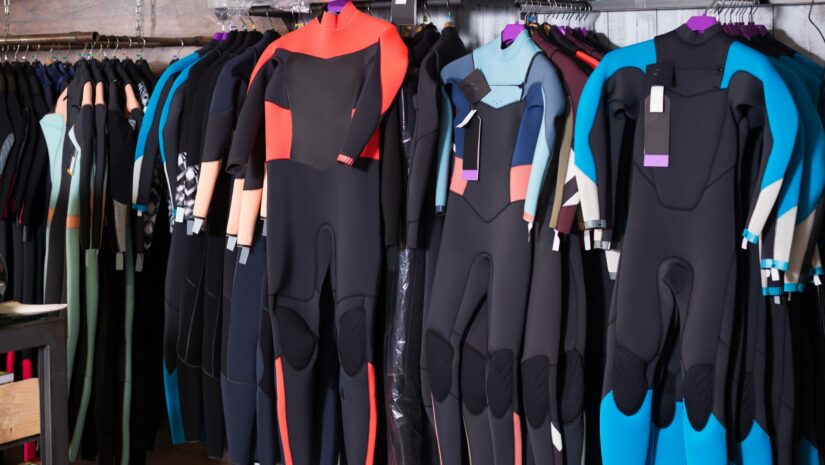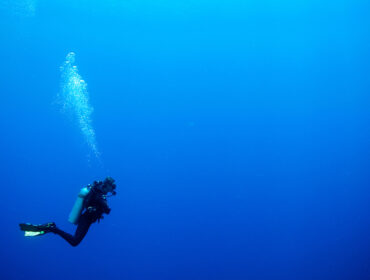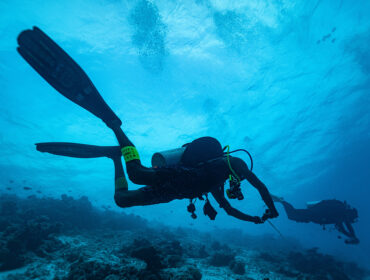Exposure suits allow your body to maintain some warmth underwater by slowing down heat loss. Body temperature decreases quickly when submerged in water, and we place ourselves at the risk of losing too much body heat when we dive without the right gear. This is why wearing an exposure suit—either a wetsuit vs drysuit—is a must.
Your will cool quickly in response to diving in waters that are cooler than your body’s temperature, and even in the warmest tropical waters you will likely still need a bit of thermal insulation to keep yourself warm and comfortable during long dives. Exposure suits also give your skin protection from the harsh sun, which divers tend not to notice when they’re underwater, despite the fact that it still affects their skin.
One common question asked by both divers and non-divers alike is: What’s the difference between a wetsuit and drysuit, and how can you tell one from the other? The most obvious answer comes from the name itself—a drysuit keeps you dry and a wetsuit does not.
In this article, we take a closer look at the main differences between the two in order to help you decide which suit is best for your needs.
Wetsuit vs Drysuit
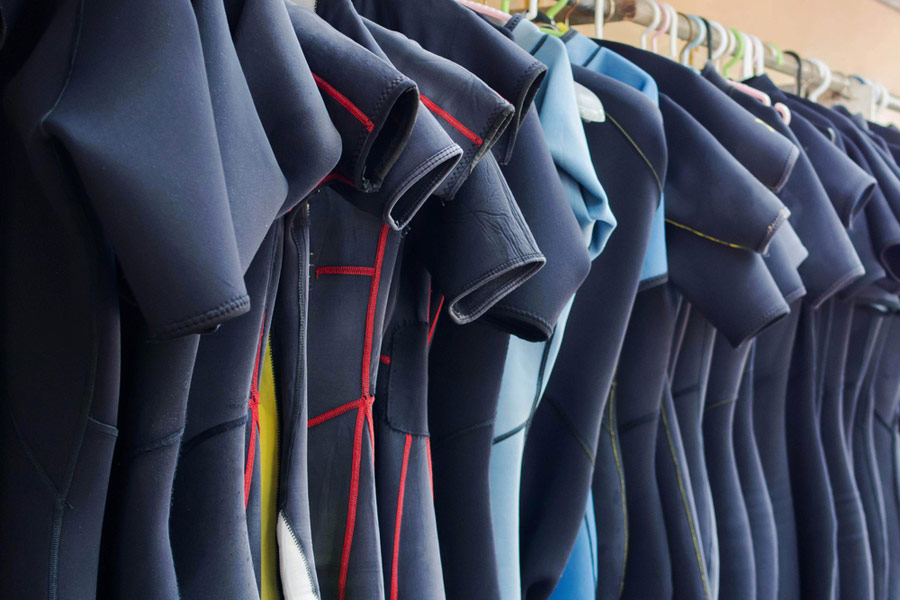
| Wetsuit | Drysuit | |
| Material | Closed-Cell Foam Neoprene | Neoprene, Rubber, or Nylon |
| Fit | Skin-Tight Fit | Loose Fit |
| Function | Insulation for Cold Waters | Insulation for Extremely Cold Waters |
What is a Wetsuit?

A wetsuit provides thermal protection for divers and works on the principle that your body is the best source of heat. To help contain this heat underwater, these suits are made with a closed-cell foam material, which is filled with thousands of tiny gas bubbles trapped within the structure. Once you enter the water, the material allows a thin layer of water through the suit, filling the space between your body and the inner layer of material. This layer of water warms up thanks to your body temperature and helps keep you comfortably insulated throughout your dive.
Scuba wetsuits are designed to fit close to the body. A loose fitting wetsuit will let water flow in and out of the gaps between the wetsuit and your skin, which means your body will end up wasting energy to heat the “new” water, making it pointless for thermal insulation.
A wetsuit also has to be thick enough to suit the temperature of the water you’re diving in. Wetsuits vary in thickness—the thicker ones provide more protection and insulation for colder waters, while the thinner ones offer lighter insulation in warmer waters. However, it’s important to remember that everyone’s body is different, which is why a specific suit’s thermal performance will normally vary from person to person. Some scuba divers can dive in tropical waters wearing only a lycra body suit, commonly known as a dive skin, while others will need a 2mm-thick (or more) wetsuit. Some scuba divers can dive in cold water wearing only a 6mm-thick wetsuit, while others need the protection of a drysuit.
When should you use a wetsuit?
A wetsuit is generally used to stop you from becoming too cold while diving in waters between 50-89˚F. Wetsuits come in a range of thickness and with different options of coverage. For warmer waters, you might choose to wear just a shorty wetsuit which covers the core but leaves the legs and arms free, for colder waters you might need a 7mm thick, full length wetsuit. People feel the cold differently and have personal preferences on styles and thicknesses, but here is a rough guide to which wetsuits are suitable for which water temperatures:
- 82-89˚F (28-32˚C): A dive skin or 1mm shorty wetsuit
- 75-84˚F (24-29˚C): A 3mm full-length wetsuit
- 65-75˚F (18-24˚C): A 5mm full-length wetsuit
- 50-65˚F (10-18˚C): A 7mm Full-length wetsuit
When choosing your wetsuit you might also want to consider sun exposure and hazards in the water. Covering your arms and legs might not be necessary for warmth, but if the dive site is prone to jellyfish, wetsuits can help to keep you protected. They also work as sun protection.
What is a Drysuit?
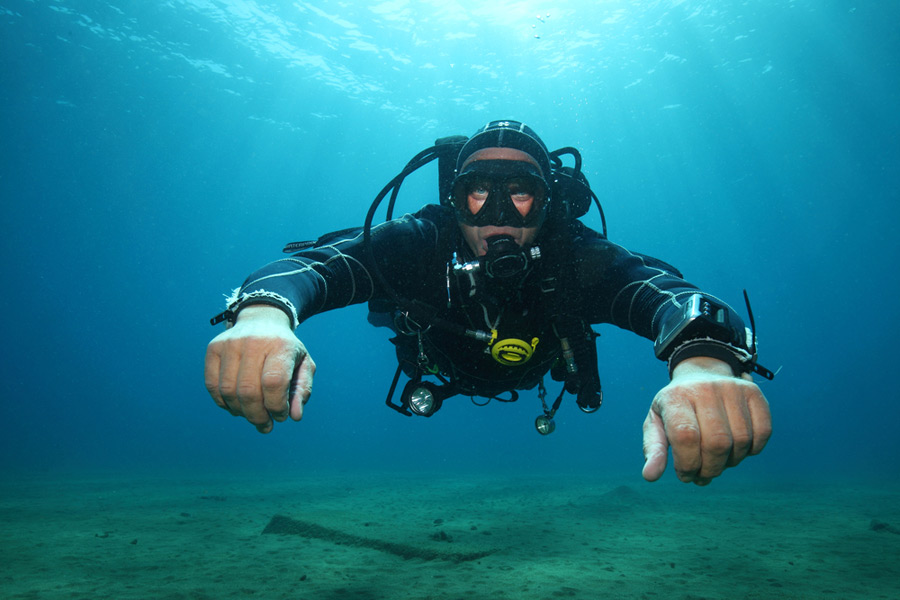
A drysuit, as the name indicates, keeps you completely dry by ensuring that no water gets into the suit. It can be made out of foam neoprene, crushed neoprene, vulcanized rubber, or heavy-duty nylon. It’s also fully sealed and uses a combination of wrist seals, a neck seal, and a waterproof zipper to keep you dry.
Drysuits fit more loosely than wetsuits and allow you to wear clothes or other insulating layers underneath. They work by keeping an insulating layer of air between the body and the suit, which you can control with inflator valves that allow you to add gas as you go deeper. Drysuits also make use of exhaust valves to release air during ascent.
The inflator valve is similar in function to the power inflator on a buoyancy compensator vest and is often situated in the middle of the chest on the suit.
Maintaining neutral buoyancy in a drysuit requires certain skills. Drysuit diving takes some getting used to and usually requires training and experience. If you’re interested in trying it out, we highly recommend receiving proper training from a qualified instructor.
When should you use a drysuit?
For temperatures lower than around 50˚F/10˚C, you should wear a wetsuit. Some divers might even choose to switch to wearing a drysuit vs a wetsuit in higher temperatures to ensure an enjoyable dive that isn’t cut short by shivering. A wetsuit works by using insulating layers that warm the small amount of water that enters the suit and sits between the neoprene and your skin. A drysuit is designed to keep you completely dry — this is more effective in keeping you warm because our body temperature becomes cold much faster in water than it does in air. A drysuit is also used by technical divers, even in warmer water temperatures, this is because they can be under the water for much longer than recreational divers are and need to ensure warmth throughout.
Comparing Wetsuits and Drysuits
If you’re trying to decide whether to purchase a wetsuit or drysuit, here are a few key differences that you should consider:
Thermal Insulation
Wetsuits use a layer of water (that is warmed by the wearer’s body) to help keep the body insulated, while drysuits use a layer of air and are fully sealed to prevent water from entering and coming into contact with the skin. The latter has the advantage here, as water conducts heat over 20 times faster than air.
Divers can wear undergarments with both suits to further increase thermal insulation, but drysuits, thanks to their loose fit, enable you to wear thicker garments underneath.
Mobility
Due to their skin-tight fit, wetsuits typically make it easier to move quickly and comfortably underwater. Drysuits, depending on the material used, are much baggier and can result in some drag as you move underwater. This means you may end up being much slower than if you had been wearing a wetsuit.
Lifespan
Drysuits are traditionally more expensive than wetsuits due to their complex construction, which enable them to work in numerous environments. Then again, even the most expensive drysuits can actually be more cost-efficient than high-quality wetsuits as the former can last over 15 years with proper care and maintenance.
Value
With the emergence of more brands and the availability of newer materials, quality entry-level drysuits now cost as much as higher-end wetsuits. However, drysuits being available at much lower prices certainly doesn’t make them lose their long-term value, as they can often retain their value for resale—unlike wetsuits, which are more likely to deteriorate after a few years of regular use.
Exposure Suit Recommendations
| Temperature* | Recommended Suit Thickness* |
| 76°F to 86°F | 1.6mm Neoprene or Lycra Dive Skin/Wetsuit |
| 69°F to 84°F | 3mm Neoprene Wetsuit |
| 64°to 77°F | 5mm Neoprene Wetsuit |
| 49°F to 75°F | 6.5mm Neoprene Wetsuit |
| 33°F to 66°F | 9.5mm Neoprene Drysuit |
*Temperature and suit thickness based on average manufacturer recommendations
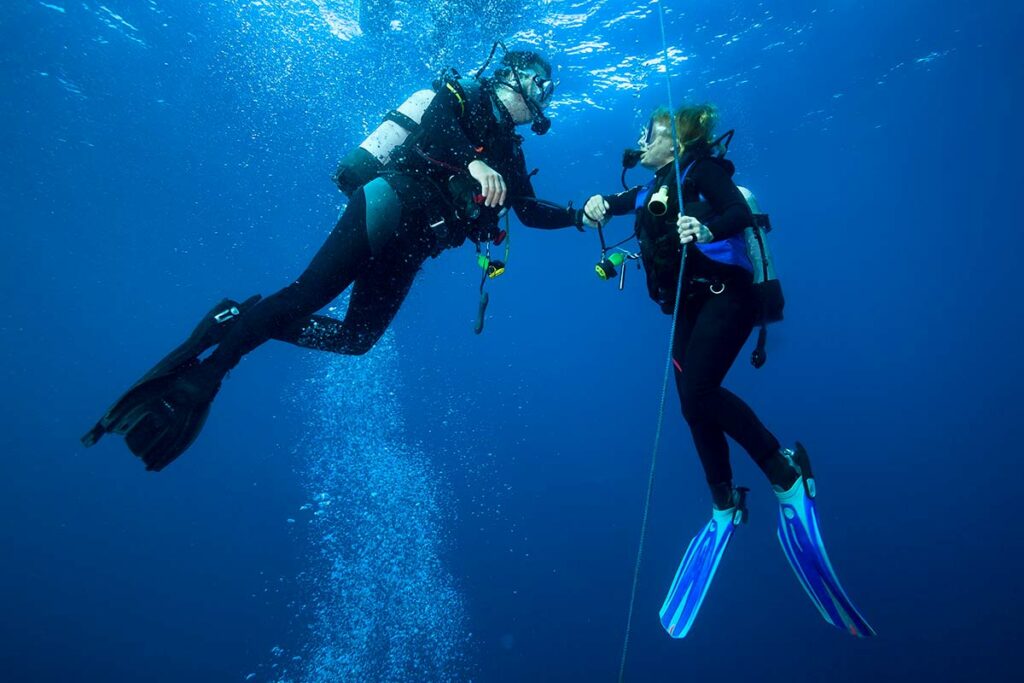
Wetsuit pros and cons
Are you having trouble deciding between a wetsuit vs a drysuit? Here are a few pros and cons to help you decide:
| Pros | Cons |
|---|---|
| Usually less bulky to carry around | Don’t keep you as warm for as long |
| Much easier to travel with than a drysuit | Take a long time to dry after diving |
| Come in a range of styles and thicknesses | |
| Cheaper than a drysuit with options for different budgets | |
| Can also be used for swimming, snorkeling, surfing, and other water sports |
Drysuit pros and cons
| Pros | Cons |
|---|---|
| Keep you warm for a long time | Quite bulky and hard to pack and travel with |
| You don’t have to get dry after a dive | A good quality drysuit is usually quite expensive |
| You don’t feel as cold after the dive with a need to warm up quickly | More difficult if you have to pee while diving (although some come with a valve) |
| Longer bottom times | |
| Useful for technical diving |
Conclusion
We hope we’ve helped you to decide between wetsuit vs drysuit, and given you all the information you need to make the right decision for you and the type of diving you’ll be doing.

